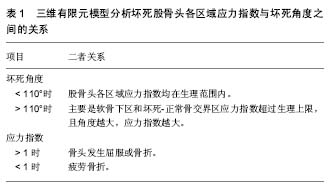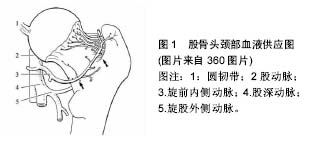| [1] Moya-Angeler J, Gianakos AL, Villa JC, et al. Current concepts on osteonecrosis of the femoral head. World J Orthop.2015; 6(8): 590-601.[2] Koch PP,Tannast M,Fujita H,et al.Minimum ten year results of total hip arthroplasty with the acetabular reinforcement ring in avascular osteonecrosis. Int Orthop.2008; 32(2): 173-179.[3] Zhao DW, Yu M, Hu K, et al.Prevalence of Nontraumatic Osteonecrosis of the Femoral Head and its Associated Risk Factors in the Chinese Population: Results from a Nationally Representative Survey. Chin Med J (Engl).2015;128(21): 2843-2850.[4] Amanatullah DF, Strauss EJ, Di Cesare PE.Current management options for osteonecrosis of the femoral head: part 1, diagnosis and nonoperative management. Am J Orthop (Belle Mead NJ).2011;40(9): E186-192.[5] Mont M, Cherian J, Sierra R, et al. Nontraumatic Osteonecrosis of the Femoral Head: Where Do We Stand Today? A Ten-Year Update. J Bone Joint Surg Am.2015; 97(19): 1604-1627.[6] Guerado E, Caso E. The physiopathology of avascular necrosis of the femoral head: an update. Injury.2016;47 Suppl 6: S16-S26.[7] Kumar MN, Belehalli P, Ramachandra P. PET/CT study of temporal variations in blood flow to the femoral head following low-energy fracture of the femoral neck. Orthopedics.2014; 37(6): e563-570.[8] Wang G, Zhang CQ, Sun Y, et al. Changes in femoral head blood supply and vascular endothelial growth factor in rabbits with steroid-induced osteonecrosis. J Int Med Res. 2010; 38(3):1060-1069.[9] Zeng X, Zhan K, Zhang L, et al. The impact of high total cholesterol and high low-density lipoprotein on avascular necrosis of the femoral head in low-energy femoral neck fractures. J Orthop Surg Res.2017;12(1): 30.[10] Mukisi M, Bashoun K, Burny F. Sickle-cell hip necrosis and intraosseous pressure. Orthop Traumatol Surg Res.2009; 95(2):134-138.[11] Jilka RL, Noble B, Weinstein RS. Osteocyte apoptosis. Bone. 2013; 54(2): 264-271.[12] Zheng L, Wang W, Ni J, et al. The association of eNOS gene polymorphism with avascular necrosis of femoral head. PloS one.2014;9(2): e87583.[13] Tian L, Wen Q, Dang X, et al. Immune response associated with Toll-like receptor 4 signaling pathway leads to steroid-induced femoral head osteonecrosis. BMC Musculoskeletal Disorders.2014;15(1): 18.[14] Lau RL, Perruccio AV, Evans HM, et al.Stem cell therapy for the treatment of early stage avascular necrosis of the femoral head: a systematic review. BMC Musculoskelet Disord. 2014; 15:156.[15] Liu BY, Zhao DW, Yu XB, et al. Effect of superior retinacular artery damage on osteonecrosis of the femoral head. Chin Med J (Engl).2013;126(20): 3845-3850.[16] Rupp RE, Rupp SN. Femoral Head Avascular Necrosis Is Not Caused by Arthroscopic Posterolateral Femoroplasty. Orthopedics.2016;39(3): 177-180.[17] 申锋,阎作勤,郭常安,等. SPECT-CT评价股骨颈骨折后股骨头血供的变化[J]. 中华关节外科杂志:电子版, 2012, 6(2): 6-8.[18] Feng Y, Yang SH, Xiao BJ, et al.Decreased in the number and function of circulation endothelial progenitor cells in patients with avascular necrosis of the femoral head. Bone.2010;46(1): 32-40.[19] Li C, Shen L,Yang Y, et al.Plasma ghrelin and von Willebrand Factor levels in patients with non-traumatic osteonecrosis of the femoral head. Hip Int.2015;25(1): 76-81.[20] Glueck CJ, Freiberg RA, Wang P. Heritable thrombophilia- hypofibrinolysis and osteonecrosis of the femoral head. Clin Orthop Relat Res.2008;466(5): 1034-1040.[21] Seguin C,Kassis J,Busque L,et al.Non-traumatic necrosis of bone (osteonecrosis) is associated with endothelial cell activation but not thrombophilia. Rheumatology (Oxford). 2008;47(8): 1151-1155.[22] 廖速成. 成人股骨头坏死的应力机制研究[D].广州中医药大学, 2015.[23] Nakamura J, Ohtori S, Watanabe A, et al. Recovery of the blood flow around the femoral head during early corticosteroid therapy: dynamic magnetic resonance imaging in systemic lupus erythematosus patients. Lupus.2012;21(3): 264-270.[24] Kim HK,Burgess J,Thoveson A,et al.Assessment of Femoral Head Revascularization in Legg-Calve-Perthes Disease Using Serial Perfusion MRI.J Bone Joint Surg Am.2016; 98(22):1897-1904.[25] Rojas E, Carlini RG, Clesca P, et al. The pathogenesis of osteodystrophy after renal transplantation as detected by early alterations in bone remodeling. Kidney Int.2003;63(5): 1915-1923.[26] Mutijima E, De Maertelaer V, Deprez M, et al. The apoptosis of osteoblasts and osteocytes in femoral head osteonecrosis: its specificity and its distribution. Clin Rheumatol.2014;33(12): 1791-1795.[27] Zhang C, Zou Y L, Ma J, et al. Apoptosis associated with Wnt/beta-catenin pathway leads to steroid-induced avascular necrosis of femoral head. BMC Musculoskelet Disord. 2015; 16:132.[28] Wang FS,Ko JY,Yeh DW,et al.Modulation of Dickkopf-1 attenuates glucocorticoid induction of osteoblast apoptosis, adipocytic differentiation, and bone mass loss. Endocrinology. 2008;149(4): 1793-1801.[29] Ko JY, Wang FS, Wang CJ, et al. Increased Dickkopf-1 expression accelerates bone cell apoptosis in femoral head osteonecrosis. Bone.2010;46(3): 584-591.[30] Hansen T, Jensen T, Clausen B, et al. Natural RNA circles function as efficient microRNA sponges. Nature.2013; 495(7441): 384-388.[31] Ha M, Kim V. Regulation of microRNA biogenesis. Nat Rev Mol Cell Biol.2014;15(8): 509-524.[32] Lewis B, Burge C, Bartel D. Conserved seed pairing, often flanked by adenosines, indicates that thousands of human genes are microRNA targets. Cell. 2005;120(1): 15-20.[33] Rupaimoole R, Slack FJ. MicroRNA therapeutics: towards a new era for the management of cancer and other diseases. Nat Rev Drug Discov.2017;16(3): 203-222.[34] Moore BT, Xiao P. MiRNAs in bone diseases. MicroRNA. 2013;2(1): 20-31.[35] Liu G, Luo G, Bo Z, et al. Impaired osteogenic differentiation associated with connexin43/microRNA-206 in steroid-induced avascular necrosis of the femoral head. Exp Mol Pathol. 2016; 101(1): 89-99.[36] Xu X, Wen H, Hu Y, et al. STAT1-caspase 3 pathway in the apoptotic process associated with steroid-induced necrosis of the femoral head. J Mol Histol.2014;45(4):473-485.[37] Hall DJ. Genetic aspects of Perthes' disease. A critical review. Clin Orthop Relat Res.1986;(209):100-114.[38] Miyamoto Y, Matsuda T, Kitoh H, et al.A recurrent mutation in type II collagen gene causes Legg-Calve-Perthes disease in a Japanese family. Hum Genet. 2007;121(5): 625-629.[39] Chen WM, Liu YF, Lin MW, et al.Autosomal dominant avascular necrosis of femoral head in two Taiwanese pedigrees and linkage to chromosome 12q13. Am J Hum Genet.2004; 75(2): 310-317.[40] Liu YF, Chen W M, Lin Y F, et al. Type II collagen gene variants and inherited osteonecrosis of the femoral head. N Engl J Med.2005;352(22): 2294-2301.[41] Kannu P, Irving M, Aftimos S, et al. Two novel COL2A1 mutations associated with a Legg-Calve-Perthes disease-like presentation. Clin Orthop Relat Res.2011; 469(6): 1785-1890.[42] Hwang J T, Baik SH, Choi JS, et al. Genetic traits of avascular necrosis of the femoral head analyzed by array comparative genomic hybridization and real-time polymerase chain reaction. Orthopedics.2011;34(1): 14.[43] Wang Y, Cao Y, Li Y, et al. Genetic association of the ApoB and ApoA1 gene polymorphisms with the risk for alcohol-induced osteonecrosis of femoral head. Int J Clin Exp Pathol.2015; 8(9): 11332-11339.[44] Balla B, Pinter C, Kosa J P, et al. Gene expression changes in femoral head necrosis of human bone tissue. Dis Markers. 2011;31(1): 25-32.[45] Ueo T,Tsutsumi S,Yamamuro T,et al. Biomechanical aspects of the development of aseptic necrosis of the femoral head.Arch Orthop Trauma Surg.1985;104(3): 145-149.[46] Yang JW, Koo KH, Lee MC, et al.Mechanics of femoral head osteonecrosis using three-dimensional finite element method . Arch Orthop Trauma Surg.2002;122(2): 88-92.[47] Kim YM, Lee SH, Lee FY,et al.Morphologic and biomechanical study of avascular necrosis of the femoral head. Orthopedics.1991;14(10): 1111-1116.[48] Daniel M,Herman S,Dolinar D,et al.Contact stress in hips with osteonecrosis of the femoral head. Clin Orthop Relat Res. 2006;447:92-99.[49] Yu T, Xie L, Chu F. A sclerotic rim provides mechanical support for the femoral head in osteonecrosis. Orthopedics. 2015;38(5): e374-9.[50] 石少辉,李子荣,王佰亮,等. 激素性股骨头坏死硬化带与骨形态蛋白关系的研究[J]. 中华外科杂志, 2010, 48(17): 1305-1308.[51] Gao YS, Guo SC, Ding H, et al. Caspase-3 may be employed as an early predictor for fractureinduced osteonecrosis of the femoral head in a canine model. Mol Med Rep.2012;6(3): 611-614.[52] Jia YB, Jiang DM, Ren YZ, et al. Inhibitory effects of vitamin E on osteocyte apoptosis and DNA oxidative damage in bone marrow hemopoietic cells at early stage of steroid-induced femoral head necrosis. Mol Med Rep.2017;15(4): 1585-1592.[53] Wang J, Kalhor A, Lu S, et al. iNOS expression and osteocyte apoptosis in idiopathic, non-traumatic osteonecrosis. Acta Orthop.2015;86(1): 134-141.[54] Bai R,Feng W, Liu W L, et al. Roles of osteocyte apoptosis in steroid-induced avascular necrosis of the femoral head. Genet Mol Res.2016;15(1). [55] Weinstein R S. Glucocorticoid-induced osteonecrosis. Endocrine.2012;41(2): 183-190. |
.jpg)


.jpg)